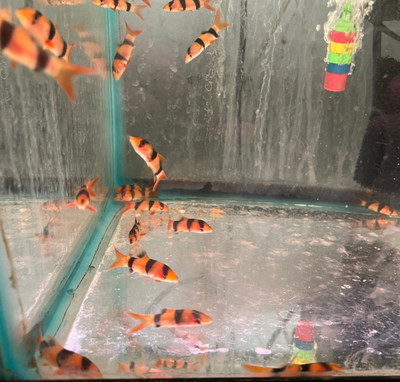Clown Loach
Posted by Max Gandara on on 2nd Jan 2024
The Clown Loach, scientifically known as Chromobotia macracanthus,
belongs to the Botiidae family. Its genome is consistent with other
loaches, and its evolution line involves adaptations to the riverine
environments of Southeast Asia. These distinctive, social freshwater
fish are recognized for their striking colors, distinct bands, and
playful behavior, making them a sought-after choice for aquarium
enthusiasts.
Summary of Aquatic Life:
Clown Loaches are peaceful and active fish that grow sizeable, reaching
up to 12 inches in captivity. They are known for their vibrant
coloration and unique behavior, often forming tight-knit groups.
Originating from the rivers of Borneo, Sumatra, and Malaysia, they
prefer well-oxygenated water with hiding spots and appreciate a diet
consisting of both sinking pellets and live or frozen foods.
Creating a Happy and Healthy Environment:
1. Tank Size: A spacious tank of at least 75 gallons for a small group.
2. Water Parameters: Maintain a temperature between 77-86°F (25-30°C) and slightly acidic to neutral pH.
3. Filtration: Efficient filtration to ensure clean and well-oxygenated water.
4. Substrate and Decor: Use soft substrates and provide ample hiding places with caves or driftwood.
5. Feeding: Offer a varied diet including sinking pellets, live or
frozen foods like bloodworms, and occasional vegetable matter.
Compatible Aquatic Life:
Fish:
1. Bala Shark (Balantiocheilus melanopterus): Similar size and peaceful temperament for a community tank.
2. Rainbowfish (Melanotaenia spp.): Colorful, schooling fish suitable for the same water conditions.
3. Denison Barb (Sahyadria denisonii): Active and compatible with Clown Loaches in a larger tank.
4. Yoyo Loach (Botia almorhae): Another loach species that coexists well in a community setup.
5. Rosy Barb (Pethia conchonius): Peaceful barbs adding variety to the aquarium.
Crustaceans:
1. Amano Shrimp (Caridina multidentata): Non-aggressive shrimp suitable for a larger setup.
2. Vampire Shrimp (Atya gabonensis): Peaceful filter-feeding shrimp compatible with Clown Loaches.
3. Bamboo Shrimp (Atyopsis moluccensis): Larger filter-feeding shrimp suitable for larger tanks.
4. Ghost Shrimp (Palaemonetes spp.): Inexpensive and harmless tank cleaners.
5. Red Claw Crab (Perisesarma bidens): Terrestrial crabs that can coexist in a semi-aquatic setup.
Plants:
1. Anubias (Anubias spp.): Hardy, low-light plants for a natural aesthetic.
2. Java Fern (Microsorum pteropus): Attaches to driftwood, providing cover for the loaches.
3. Vallisneria (Vallisneria spp.): Tall, grass-like plants for the background.
4. Cryptocoryne (Cryptocoryne spp.): Rooted plants adding to the overall habitat.
5. Amazon Sword (Echinodorus amazonicus): Larger plants suitable for spacious tanks.
Bugs:
1. Bloodworms: High-protein live or frozen food.
2. Brine Shrimp: Excellent for conditioning and variety in diet.
3. Daphnia: Nutrient-rich live food for Clown Loaches.
4. Tubifex Worms: Live or frozen food, providing a protein-rich option.
5. Mosquito Larvae: Natural and occasional live food.
Amphibians:
1. Dwarf African Clawed Frog (Hymenochirus spp.): Peaceful aquatic frogs.
2. Fire-Bellied Newt (Cynops spp.): Semi-aquatic newts suitable for a shared habitat.
3. African Dwarf Frog (Hymenochirus curtipes): Small, aquatic frogs compatible with Clown Loaches.
4. Oriental Fire-Bellied Toad (Bombina orientalis): Colorful toads for a unique aquatic setup.
5. Mudskipper: Brackish water amphibian, providing a dynamic ecosystem.
These considerations contribute to a diverse and balanced aquatic
community, ensuring the well-being of Clown Loaches and their tankmates.

